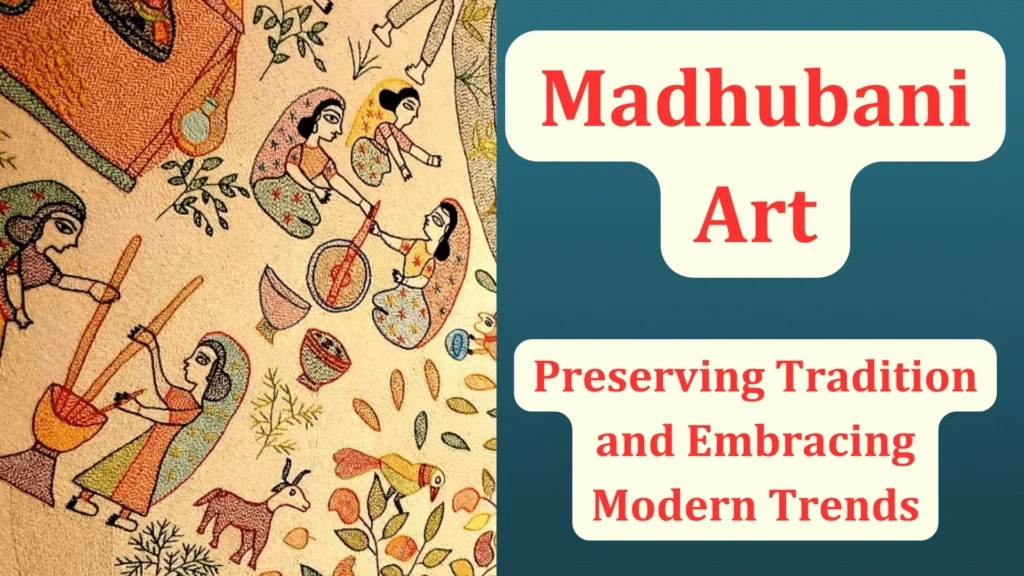
Introduction
Brief Introduction to Madhubani Art
Madhubani Art, or Mithila painting, is a distinctive and traditional art form that hails from the Mithila region in Bihar, India. Renowned for its vibrant colors, intricate patterns, and eye-catching designs, this art form has been practiced by the women of the region for centuries. Madhubani paintings are characterized by their use of natural dyes and pigments, and they often depict nature, mythology, and daily life.
Historical Background and Significance of Madhubani Art
The origins of Madhubani Art can be traced back to ancient times, with its roots deeply embedded in the cultural and religious practices of the Mithila region. Traditionally, these paintings were created on the walls and floors of homes to mark special occasions and festivals. The art form holds immense cultural significance, as it reflects the life, beliefs, and values of the local people. Madhubani Art has not only been a means of artistic expression but also a way to preserve and pass down cultural heritage through generations.
Historical Evolution
Connection to Ramayana and the Mithila Kingdom
Madhubani Art, also known as Mithila painting, traces its origins back to ancient times, with a rich connection to the epic Ramayana and the historic Mithila kingdom. According to legend, King Janaka of Mithila commissioned the women of his kingdom to decorate the walls and floors of their homes with intricate murals to celebrate the marriage of his daughter, Sita, to Lord Rama. This practice not only marked auspicious occasions but also depicted the deep cultural and religious ties within the community. The art form’s connection to the Ramayana highlights its long-standing tradition and significance in the Mithila region.
From Traditional Wall Art to Modern Canvases
Madhubani Art has undergone significant evolution over the centuries. Initially, it was a domestic ritual art form practiced exclusively by women on the walls and floors of their homes using natural materials such as mud, cow dung, and rice paste. The designs were drawn with twigs, fingers, and brushes made from natural fibers. This form of art was a communal activity, often passed down from mother to daughter, and it played a crucial role in social and religious ceremonies.
As time progressed, the scope of Madhubani Art expanded beyond household walls. The mid-20th century brought significant changes, especially during the 1960s drought in Bihar. To provide an alternative source of income for the women of the Mithila region, the All India Handicrafts Board encouraged them to transfer their traditional art onto paper and canvas. This transition from ephemeral wall art to durable, portable mediums marked a pivotal point in the history of Madhubani Art. The use of paper and cloth not only preserved the art form but also allowed it to reach a wider audience.
Recognition and Resurgence in Contemporary Times
In the mid-20th century, Madhubani Art gained recognition beyond the confines of the Mithila region. During a severe drought in Bihar in the 1960s, the All-India Handicrafts Board encouraged local women to create their traditional paintings on paper as a means of livelihood. This initiative not only helped the artists economically but also brought Madhubani Art to national and international attention. Since then, the art form has seen a resurgence, with artists gaining acclaim and opportunities to showcase their work globally. Today, Madhubani Art is celebrated for its aesthetic beauty and cultural significance, and it continues to inspire contemporary artists and art enthusiasts alike.
Characteristics of Madhubani Art
Distinctive Features and Techniques
Use of Natural Dyes and Pigments
One of the most distinctive features of Madhubani Art is the use of natural dyes and pigments. Traditionally, artists use colors derived from plants, minerals, and other natural sources. For example, black is made from the soot of lamps, yellow from turmeric, blue from indigo, red from the juice of the kusum flower or red sandalwood, and green from the leaves of the apple tree. This use of natural materials not only ensures the sustainability of the art form but also gives the paintings a unique vibrancy and depth.
Intricate Patterns and Geometric Designs
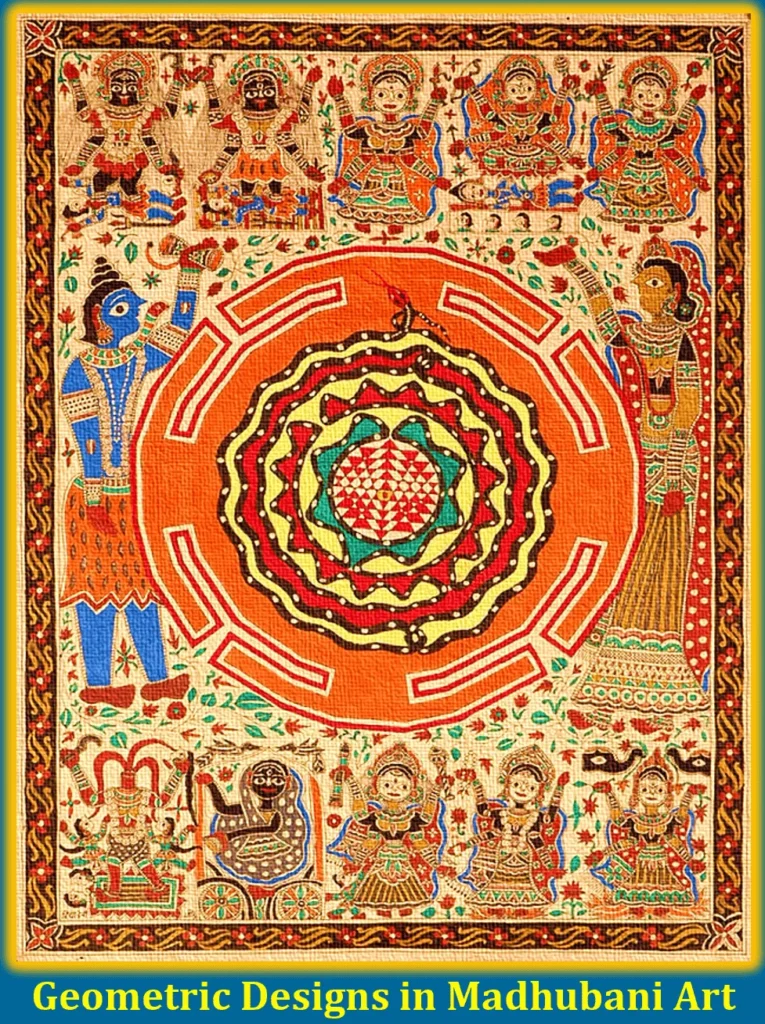
Madhubani Art is renowned for its intricate patterns and geometric designs. The paintings often feature repetitive motifs, including flowers, leaves, and various geometric shapes. These patterns are meticulously crafted, creating a sense of symmetry and harmony in the artwork. The detailed line work, filled with delicate strokes and fine detailing, is a hallmark of Madhubani Art, showcasing the incredible skill and patience of the artists.
Depiction of Nature, Mythology, and Social Issues
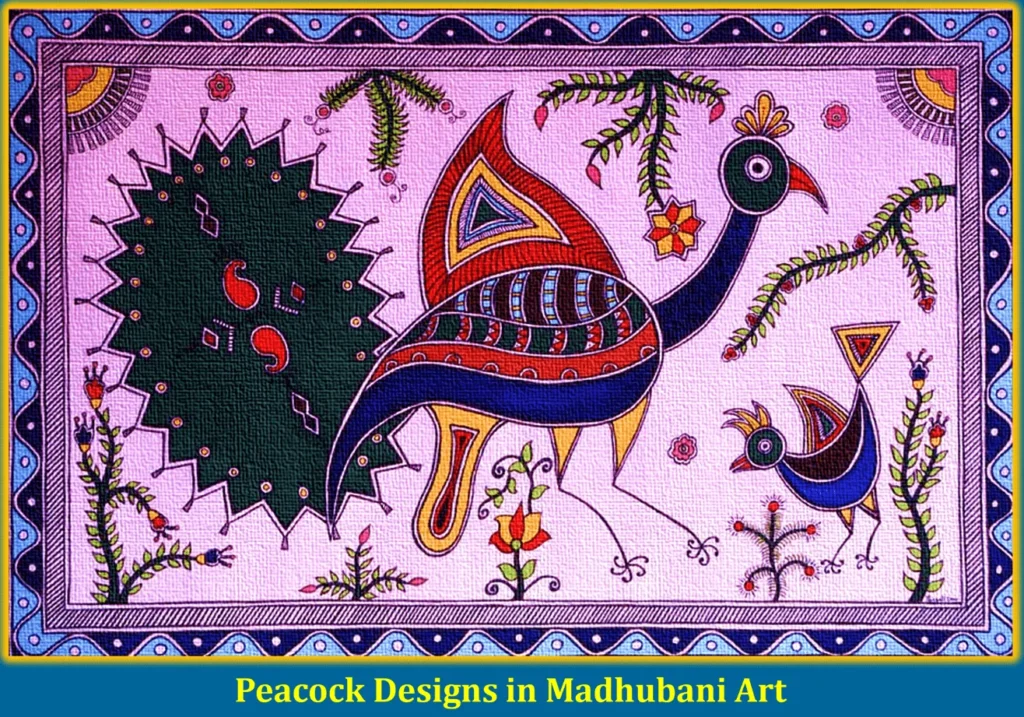
The themes of Madhubani paintings are diverse and rich, often depicting scenes from nature, mythology, and social issues. Nature plays a central role, with common motifs including animals, birds, fish, and trees, particularly the peepal and lotus. Mythological themes frequently illustrate stories from Hindu epics such as the Ramayana and Mahabharata, featuring deities like Krishna, Rama, Durga, and Lakshmi. Additionally, contemporary Madhubani artists have begun to incorporate social and political themes into their work, addressing issues such as deforestation, women’s rights, and education, thereby making the art form relevant to modern times.
Styles within Madhubani Art
Bharni Style
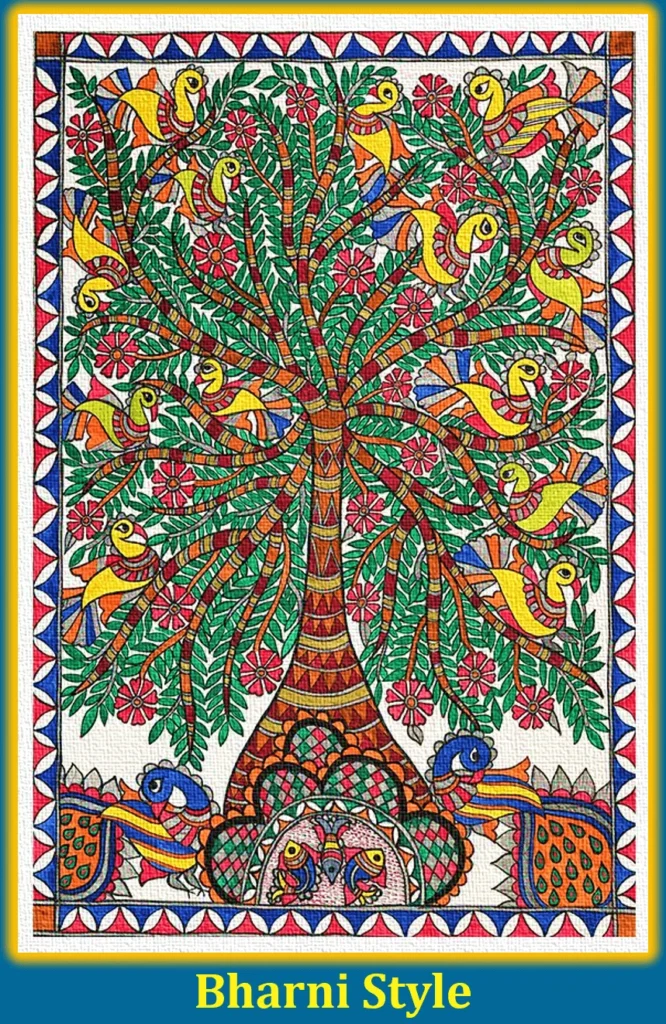
The Bharni style of Madhubani Art is characterized by its use of vibrant colors and intricate detailing. Traditionally practiced by upper-caste women, Bharni paintings often depict mythological scenes and deities. The figures are typically filled with solid colors, and the backgrounds are intricately decorated with fine patterns and designs.
Kachni Style
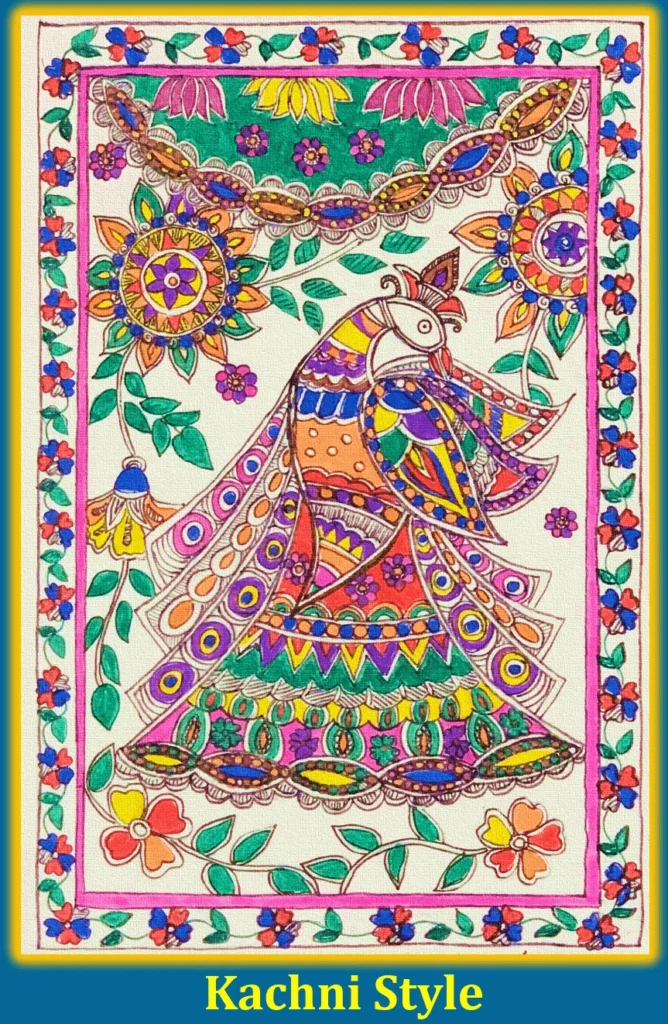
The Kachni style is known for its monochromatic color scheme and fine line work. Instead of filling the figures with solid colors, the Kachni style uses delicate lines to create patterns and textures within the shapes. This style often features a black-and-white or a single-color palette, highlighting the intricacy of the line work and the complexity of the patterns.
Tantrik Style
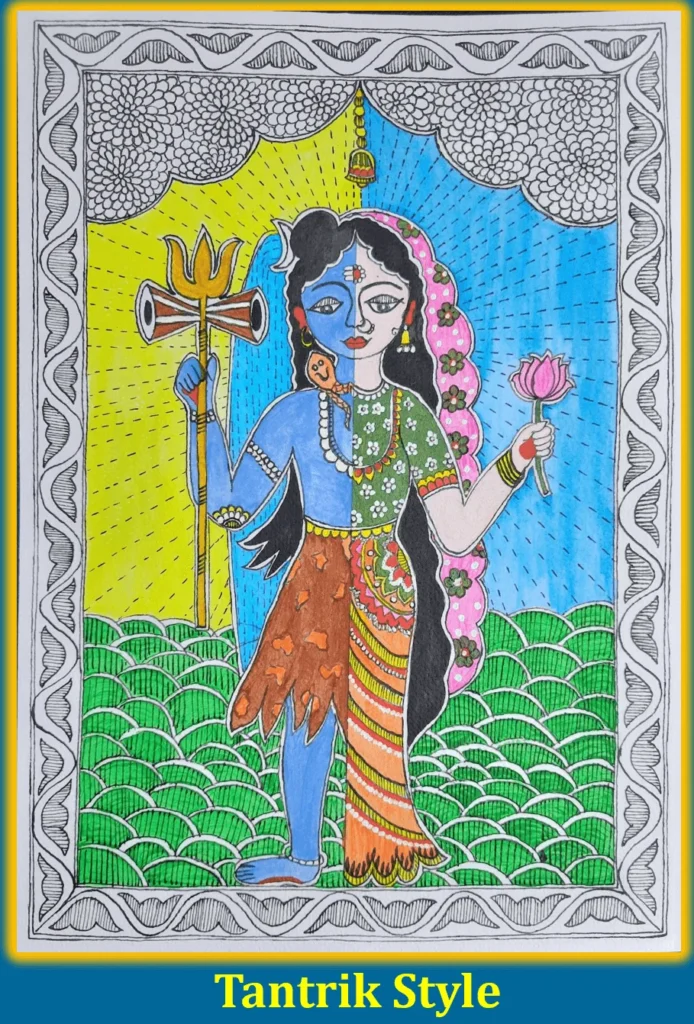
The Tantrik style of Madhubani Art is deeply rooted in spiritual and religious symbolism. It often depicts tantric motifs and themes, including yantras, mandalas, and representations of Hindu deities with a focus on their mystical and esoteric aspects. The use of bold colors and detailed iconography is a hallmark of this style, aimed at invoking spiritual contemplation and reverence.
Godna Style
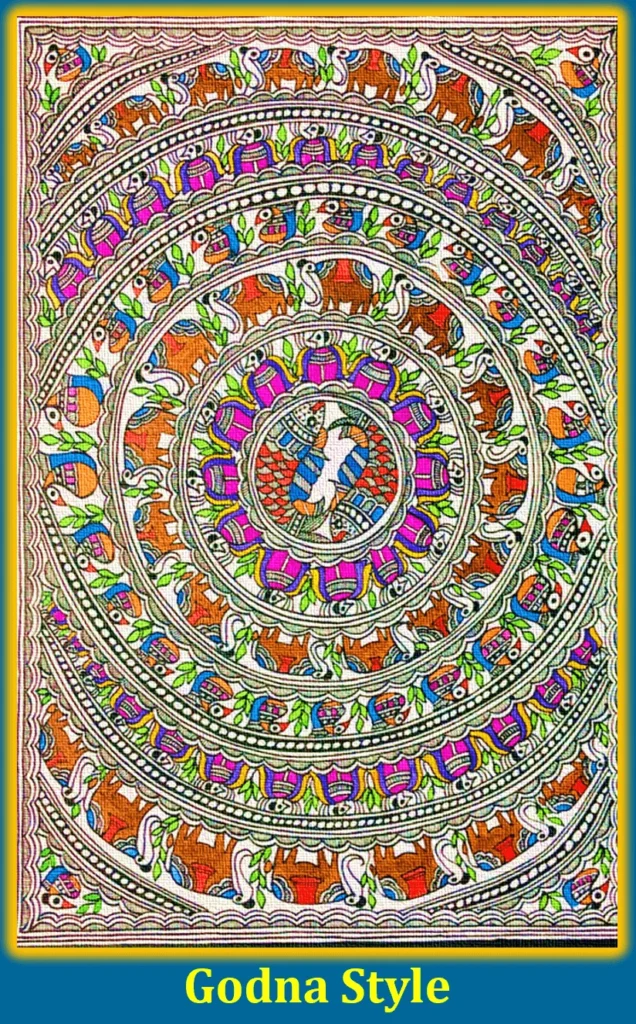
Godna, or tattoo style, is inspired by the traditional tattoo art practiced by the rural communities of Mithila. This style often features patterns and motifs similar to those used in body art, including geometric shapes, flora, and fauna. Godna paintings are typically created using a monochromatic palette, emphasizing the intricate line work and repetitive patterns.
Kohbar Style
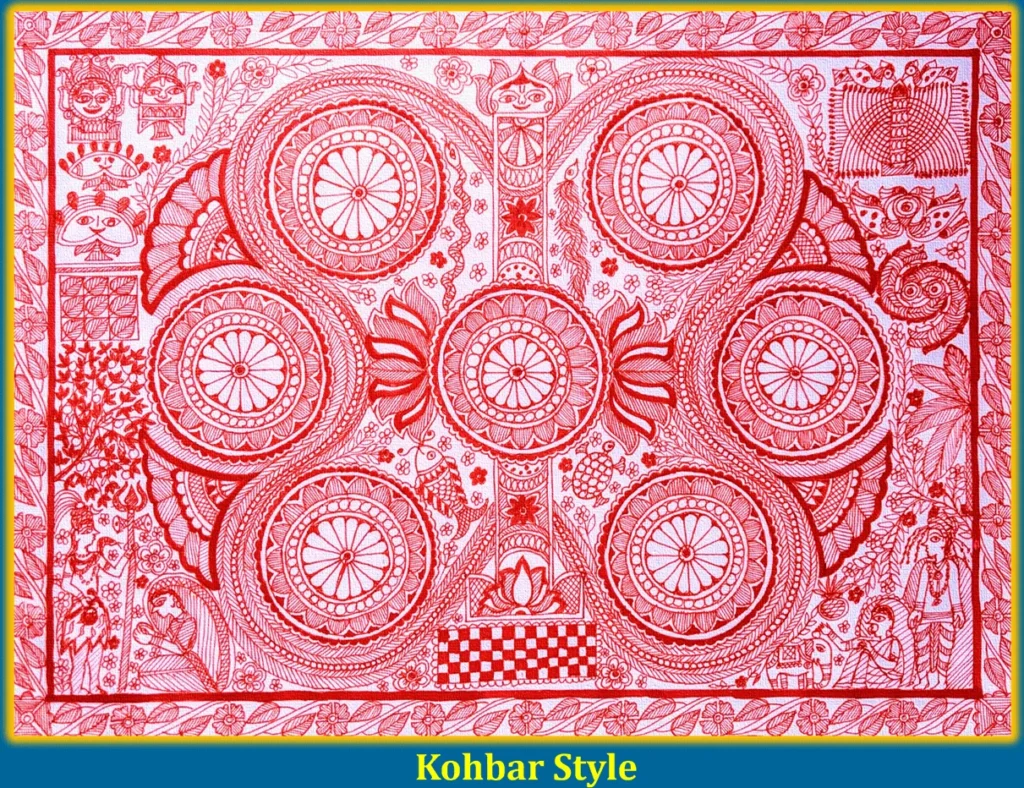
The Kohbar style is associated with nuptial ceremonies and is traditionally painted on the walls of the bridal chamber. These paintings are rich in symbolic motifs related to fertility, love, and prosperity, such as lotus flowers, bamboo groves, fish, birds, and celestial bodies. The Kohbar style is characterized by its vibrant use of colors and dense, detailed compositions that celebrate marital bliss and the continuity of life.
Cultural and Social Significance
Role in Social and Religious Ceremonies
Madhubani Art holds a pivotal role in the social and religious fabric of the Mithila region. Traditionally, it is an integral part of various ceremonies and rituals, particularly weddings. The Kohbar ghar, or bridal chamber, is adorned with elaborate Madhubani paintings that symbolize fertility, love, and prosperity. These paintings are created by the women of the family, emphasizing communal participation and the transmission of cultural practices across generations. During festivals such as Holi, Diwali, and Durga Puja, homes are decorated with Madhubani murals depicting deities and auspicious symbols, enhancing the spiritual ambiance and invoking divine blessings.
Preservation of Cultural Heritage and Traditional Knowledge
Madhubani Art plays a crucial role in preserving the cultural heritage and traditional knowledge of the Mithila region. The art form is a living tradition, passed down through generations, predominantly by women. This intergenerational transmission ensures the continuity of cultural identity and artistic skills. The preservation of Madhubani Art is not just about maintaining aesthetic practices but also about safeguarding a way of life and a worldview that has been shaped over centuries.
In contemporary times, efforts to preserve and promote Madhubani Art have gained momentum. Government initiatives, non-governmental organizations, and cultural institutions have supported Madhubani artists by providing platforms for their work, organizing exhibitions, and facilitating access to markets. Educational programs and workshops are conducted to teach younger generations the traditional techniques and motifs, ensuring that the art form adapts and thrives in a modern context.
Moreover, the global recognition of Madhubani Art has encouraged artists to innovate while staying true to their roots. By incorporating contemporary themes and experimenting with new mediums, artists are able to keep the tradition relevant and engaging for both local and international audiences.
The Process of Creating Madhubani Art
Materials Used: Paper, Cloth, Walls, and Other Mediums
Madhubani Art is traditionally created on various surfaces, each requiring different techniques and materials. Originally, the art was painted on the walls and floors of homes using materials readily available in the Mithila region. Over time, artists began to use other mediums to preserve the art and reach a broader audience.
- Walls and Floors: Traditional Madhubani paintings are often created on mud walls and floors of village homes. The surfaces are first coated with a mixture of mud and cow dung, which acts as a natural primer.
- Paper: With the commercialization and globalization of the art form, handmade paper became a popular medium. It allows for easier transportation and preservation of the artworks.
- Cloth: Fabrics such as cotton and silk are also used, particularly for creating wearable art and decorative items.
- Canvas: Modern Madhubani artists frequently use canvas to create more durable and versatile pieces.
Step-by-Step Process: From Sketching to the Final Product
- Preparation of Surface: Depending on the medium, the surface is prepared. For walls and floors, a base layer of mud and cow dung is applied. For paper, cloth, or canvas, a light sketch is made using a pencil or a piece of charcoal.
- Sketching: The artist begins by outlining the design with a fine brush or pen. Traditional designs often include intricate borders and central motifs, such as gods, goddesses, animals, and nature scenes.
- Detailing: Once the outline is complete, the artist fills in the details. Patterns and motifs are added to the main figures and background, creating a rich tapestry of lines and shapes.
- Coloring: Natural dyes and pigments are applied. Colors are typically filled in sections, with each area being carefully painted to avoid bleeding into adjacent sections. Traditional colors are vibrant and include reds, yellows, blues, greens, and blacks.
- Final Touches: After the colors dry, the final touches are added, including fine details and additional patterns to enhance the overall composition. Once completed, the painting is set aside to dry thoroughly.
Role of Women Artists and Community Involvement
Women have been the primary custodians and practitioners of Madhubani Art. Traditionally, this art form has been passed down from mother to daughter, ensuring that the skills and knowledge remain within the community. Women artists play a crucial role in preserving cultural heritage and fostering community ties through collaborative efforts.
The creation of Madhubani Art often involves the participation of the entire community, especially during festivals and important ceremonies. This communal aspect not only strengthens social bonds but also ensures the art form’s continuity and evolution.
Tools Used in Madhubani Art
Commonly Used Tools for Painting and Their Significance
- Twigs and Brushes: Originally, twigs and bamboo sticks were used for outlining and detailing. Brushes made from natural fibers, such as goat hair, are also common.
- Pens and Nibs: Modern artists often use fine-tipped pens and nibs for intricate line work and detailing.
- Natural Pigments: Colors derived from natural sources like flowers, leaves, and minerals are significant for their traditional and eco-friendly attributes.
Innovations in Tools and Techniques Over Recent Years
Recent years have seen innovations in both tools and techniques used in Madhubani Art:
- Synthetic Colors: While traditional artists prefer natural pigments, some contemporary artists use synthetic colors for convenience and consistency.
- Modern Brushes and Pens: The introduction of fine art brushes and waterproof pens has allowed for more precision and durability in artworks.
- Digital Tools: Some artists are experimenting with digital tools to create Madhubani designs, expanding the art form’s reach to new audiences and mediums.
Madhubani Art, with its rich cultural heritage and distinctive techniques, continues to evolve while maintaining its traditional essence. The process of creating Madhubani Art, from the preparation of materials to the involvement of the community, showcases the dedication and craftsmanship of the artists. The role of women and the adoption of new tools and techniques ensure that this vibrant art form remains relevant and celebrated in contemporary times.
The Symbolism in Madhubani Art
Nature and Its Representation
Significance of Flora and Fauna in the Artwork
Nature holds a central place in Madhubani Art, with flora and fauna being recurrent motifs. Plants, trees, animals, and birds are depicted not just for their aesthetic appeal but also for their symbolic meanings. Common elements include the peepal tree, which signifies life and fertility; fish, which symbolize good luck and prosperity; and birds like peacocks and parrots, representing beauty and love. These natural elements are intricately woven into the fabric of Madhubani paintings, reflecting the deep connection between the community and their environment.
Interpretation of Natural Elements and Their Symbolism
Each natural element in Madhubani Art carries specific symbolic meanings. For instance, the lotus flower often represents purity and spiritual awakening, while elephants signify strength and wisdom. The sun and moon are also frequently depicted, symbolizing the eternal cycle of life and time. These interpretations are not merely decorative but are deeply embedded in the cultural and religious beliefs of the Mithila people.
Connection Between Nature and Spirituality in Madhubani Themes
Madhubani Art often illustrates the profound relationship between nature and spirituality. Natural elements are used to convey spiritual themes, such as the interconnectedness of life and the divine. The harmonious depiction of nature in these artworks reflects the belief that nature is a manifestation of the divine, and maintaining a balance with the natural world is essential for spiritual well-being.
Mythological Narratives
Depiction of Hindu Deities and Mythological Stories

Mythological narratives are a cornerstone of Madhubani Art. Paintings frequently depict scenes from Hindu epics such as the Ramayana and Mahabharata, featuring gods and goddesses like Rama, Sita, Krishna, and Durga. These depictions serve as visual storytelling, preserving and propagating religious and cultural stories through generations. The detailed portrayal of deities and mythological events underscores the community’s devotion and reverence for their religious heritage.
The Cycle of Life and Death as Portrayed in the Art
Madhubani Art often explores the themes of life and death, reflecting the cyclical nature of existence. Scenes depicting birth, marriage, and death rituals are common, highlighting the artist’s understanding of the transient yet continuous journey of life. This portrayal emphasizes the belief in rebirth and the perpetual cycle of life, death, and regeneration, which are central to Hindu philosophy.
Role of Storytelling in Preserving Cultural Heritage Through Art
The narrative aspect of Madhubani Art plays a crucial role in preserving cultural heritage. Each painting tells a story, whether it be mythological, historical, or social. These visual narratives are an effective means of passing down traditions, values, and knowledge from one generation to the next. Through these stories, Madhubani Art keeps the rich cultural heritage of the Mithila region alive and vibrant.
Social and Political Commentary
Art as a Reflection of Societal Norms and Values
Madhubani Art serves as a mirror to societal norms and values. The themes often reflect the daily lives, customs, and traditions of the Mithila people. Social roles, family structures, and communal activities are depicted, providing insights into the community’s way of life. This reflection helps in understanding the societal framework and the cultural ethos of the region.
Use of Madhubani Art to Express Political Thoughts and Movements
In contemporary times, Madhubani Art has also become a medium for political expression. Artists have used their work to comment on political issues, social injustices, and movements. For example, paintings addressing deforestation, women’s rights, and social reforms have brought attention to these issues, showcasing the power of art as a tool for advocacy and change. This political dimension adds a layer of modern relevance to the traditional art form.
The Role of Women and Empowerment Within the Art Community
Women have been the primary custodians of Madhubani Art, and their role extends beyond the creation of artwork. The art form has provided a means of empowerment for many women, offering them a source of income and recognition. The community aspect of Madhubani Art fosters solidarity among women, encouraging them to preserve their cultural heritage while gaining economic independence. This empowerment through art has been instrumental in uplifting the status of women in the Mithila region.
Prominent Madhubani Artists and Their Contributions
Celebrated Artists: Sita Devi, Ganga Devi, Mahasundari Devi
Sita Devi
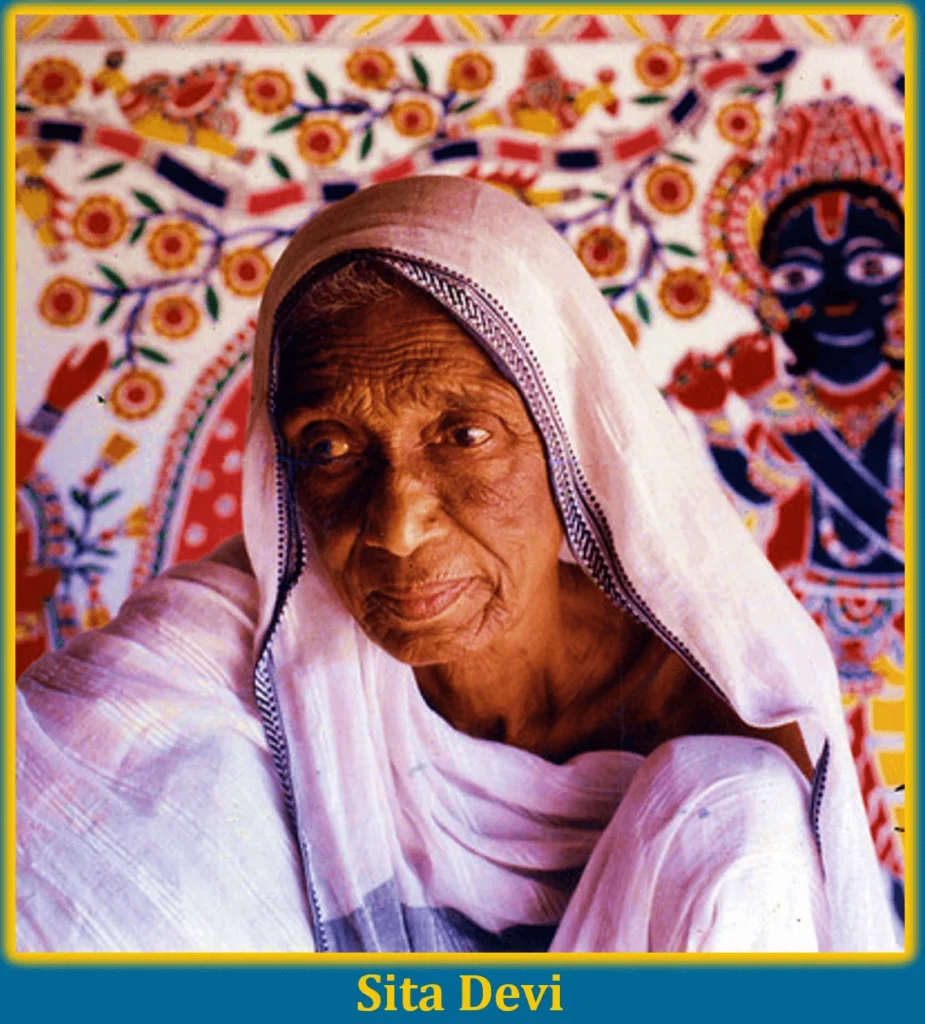
Sita Devi was one of the most renowned Madhubani artists, celebrated for her intricate and vibrant works. She played a significant role in bringing Madhubani Art to a global audience. Her use of bold colors and detailed patterns made her work stand out, earning her several accolades, including the Padma Shri in 1981. Sita Devi’s contribution to the art form lies not only in her artistic prowess but also in her efforts to teach and promote Madhubani Art among younger generations.
Ganga Devi
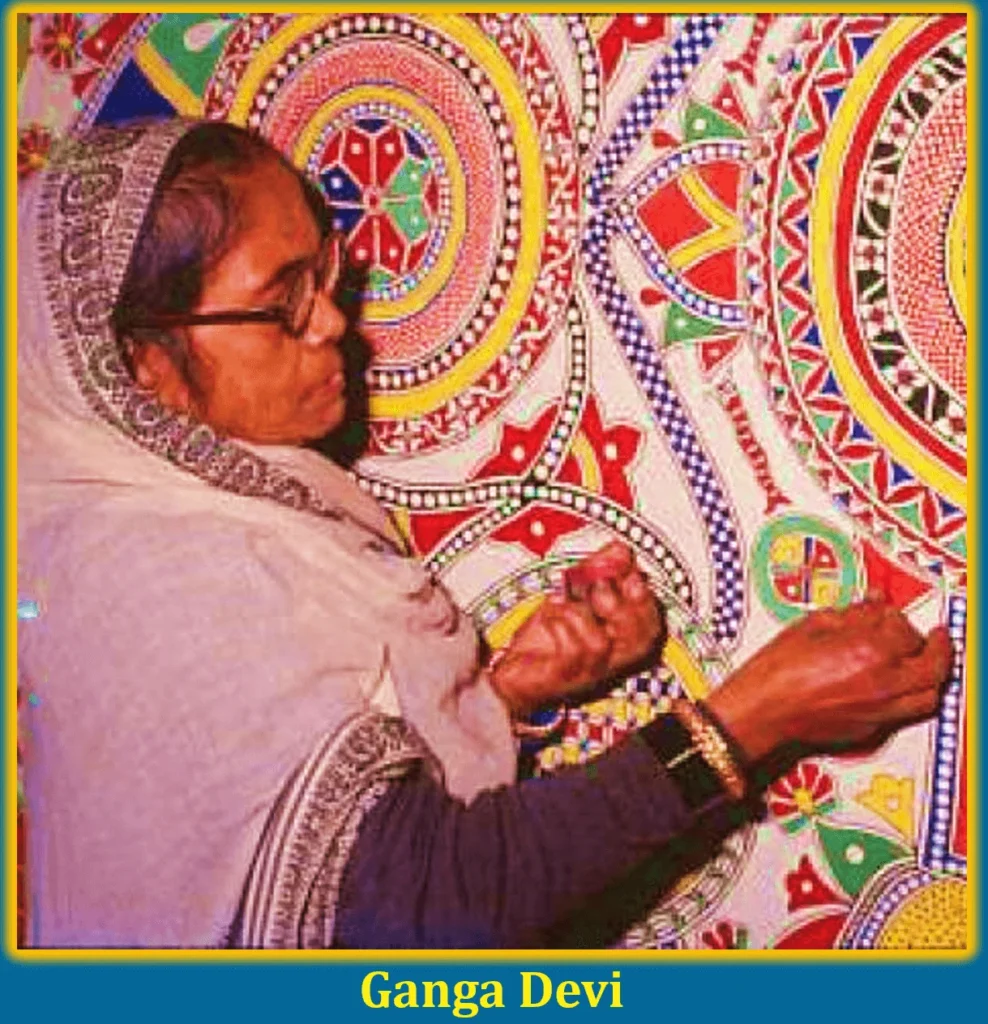
Ganga Devi was another influential figure in the world of Madhubani Art. Known for her exquisite line work and the depiction of mythological and tantric themes, she contributed significantly to the preservation and innovation of the art form. Ganga Devi received the Padma Shri in 1984 and represented India in various international exhibitions, thus playing a crucial role in elevating Madhubani Art on the global stage. Her autobiography, which includes her own illustrations, provides valuable insights into her life and the evolution of Madhubani Art.
Mahasundari Devi
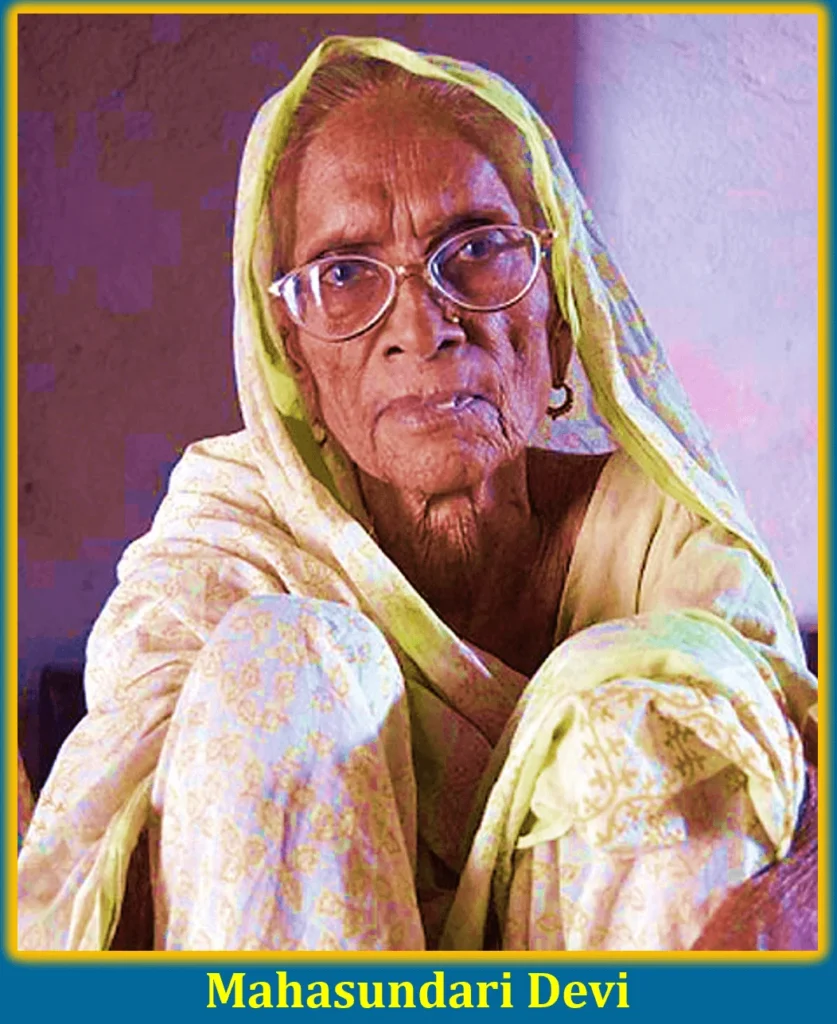
Mahasundari Devi was a pioneering Madhubani artist whose work has been instrumental in sustaining the traditional art form. She received the Padma Shri in 2011 for her contributions to Indian art. Mahasundari Devi’s paintings are known for their thematic richness and intricate detailing. She was also dedicated to mentoring young artists, ensuring the transmission of skills and cultural heritage to future generations.
Life of a Madhubani Artist
Daily Life and Routine Challenges Faced by Artists
The daily life of a Madhubani artist is a blend of artistic creation and managing household responsibilities. Many artists, particularly women, balance their time between painting and fulfilling domestic duties. Financial challenges are common, as the market for traditional art can be unpredictable. Access to quality materials and fair compensation for their work are ongoing issues. Despite these challenges, the passion for art and the desire to preserve their cultural heritage drive these artists to continue their practice.
Training and the Transmission of Skills Through Generations
Training in Madhubani Art typically begins at a young age, with skills and techniques being passed down from one generation to the next. This intergenerational transmission ensures the preservation of traditional motifs and methods. Mothers and grandmothers teach the younger members of the family, fostering a deep sense of community and cultural continuity. Formal training programs and workshops have also emerged, providing structured education and opportunities for aspiring artists to learn from established practitioners.
The Impact of Commercialization on Traditional Practices
The commercialization of Madhubani Art has had both positive and negative impacts. On one hand, it has provided artists with new avenues for income and broader recognition. The shift from wall murals to portable mediums like paper and canvas has made the art more accessible to a global audience. However, commercialization has also led to concerns about the dilution of traditional practices. Mass production and the pressure to cater to market demands can sometimes compromise the authenticity and cultural significance of the art form.
Contributions to the Global Recognition of Madhubani Art
Prominent Madhubani artists have played a vital role in gaining international recognition for this traditional art form. Through exhibitions, collaborations, and cultural exchanges, artists like Sita Devi, Ganga Devi, and Mahasundari Devi have showcased the beauty and cultural richness of Madhubani Art to audiences worldwide. Their participation in international events and the publication of their works have helped establish Madhubani Art as an important part of global cultural heritage.
Impact on Local Communities and the Empowerment of Women
Madhubani Art has had a significant impact on local communities, particularly in empowering women. The art form provides a source of income and economic independence for many women in the Mithila region. It also offers a platform for women to express their creativity and cultural identity. Community-based initiatives and cooperatives have emerged, supporting artists and fostering a sense of solidarity. These initiatives help preserve the art form and contribute to the socio-economic development of the region.
Madhubani Art in Modern Times
Contemporary Adaptations and Innovations
Madhubani Art has continually evolved to remain relevant in modern times. Contemporary adaptations and innovations have played a significant role in ensuring the art form’s sustainability and global appeal.
Expansion to New Mediums
While traditional Madhubani Art was primarily created on walls and floors, modern artists have expanded their canvases to include paper, cloth, canvas, and even digital platforms. This expansion has made the art more accessible and portable, allowing it to reach a wider audience.
Fusion with Modern Art Forms
Contemporary Madhubani artists often blend traditional techniques with modern art forms. This fusion can be seen in mixed media artworks that combine Madhubani patterns with abstract or realistic elements. Such innovations help bridge the gap between traditional and modern aesthetics, attracting younger and more diverse audiences.
Introduction of New Themes
While traditional Madhubani Art primarily depicted mythological and nature-based themes, contemporary artists are incorporating modern and global themes. Issues such as gender equality, environmental conservation, and social justice are being explored through the lens of Madhubani Art. This thematic diversification not only makes the art form more relevant but also positions it as a medium for social commentary.
Role in Promoting Sustainable and Eco-Friendly Art Practices
Madhubani Art has long been associated with sustainability and eco-friendly practices, a tradition that continues and adapts in modern times.
Use of Natural Materials
One of the hallmarks of Madhubani Art is the use of natural dyes and pigments derived from plants, minerals, and other organic sources. These natural colors are not only vibrant but also environmentally friendly. Artists use materials such as turmeric, indigo, rice paste, and soot to create their palettes, maintaining a strong connection to nature.
Eco-Friendly Techniques
The traditional techniques of Madhubani Art emphasize minimal waste and the sustainable use of resources. For instance, natural brushes made from twigs and bamboo sticks are used instead of synthetic materials. Additionally, the practice of painting on recycled paper and cloth helps reduce the environmental impact.
Advocacy and Awareness
Modern Madhubani artists are also playing a crucial role in advocating for sustainable and eco-friendly practices. Through their art, they raise awareness about environmental issues and promote a message of conservation. Exhibitions and workshops often include educational components that highlight the importance of sustainability, inspiring both artists and audiences to adopt eco-friendly practices.
Community Initiatives
Various community-based initiatives have emerged to support sustainable Madhubani Art practices. These initiatives often focus on empowering local artists, particularly women, by providing them with resources and training in sustainable techniques. Such efforts help preserve traditional methods while encouraging innovation and adaptation in a way that respects the environment.
Global Recognition and Commercialization
Exhibitions and International Showcases
Madhubani Art has gained substantial global recognition through numerous exhibitions and international showcases. These events have played a crucial role in bringing this traditional Indian art form to a worldwide audience.
Prominent Exhibitions
Madhubani Art has been featured in prominent art galleries and museums around the world. For example, the Museum of Sacred Art in Belgium has hosted exhibitions highlighting the intricate beauty and cultural significance of Madhubani paintings. Similarly, the Crafts Museum in New Delhi regularly showcases Madhubani Art, attracting visitors from across the globe.
International Festivals and Cultural Exchanges
International cultural festivals, such as the Smithsonian Folklife Festival in the United States, have provided platforms for Madhubani artists to demonstrate their skills and share their stories. These festivals promote cross-cultural understanding and appreciation, allowing audiences to experience the rich heritage of Madhubani Art firsthand.
Online Platforms and Digital Exhibitions
With the advent of digital technology, online platforms have become significant avenues for promoting Madhubani Art. Virtual exhibitions and online galleries have made it possible for art enthusiasts worldwide to explore and purchase Madhubani artworks. Social media and e-commerce websites have further expanded the reach of this art form, connecting artists directly with global buyers.
Challenges and Opportunities in the Commercialization of Madhubani Art
The commercialization of Madhubani Art has brought both challenges and opportunities for artists and the preservation of the art form.
Economic Benefits and Livelihood Opportunities
Commercialization has provided significant economic benefits to Madhubani artists, particularly women. It has opened up new livelihood opportunities, allowing artists to earn a sustainable income from their work. This financial stability has empowered many artists, enabling them to support their families and communities.
Market Demand and Quality Control
The growing market demand for Madhubani Art has sometimes led to concerns about maintaining quality and authenticity. Mass production and commercialization can result in the dilution of traditional techniques and motifs. Ensuring that commercial products meet high standards while preserving the integrity of the art form remains a critical challenge.
Artistic Freedom and Innovation
While commercialization has introduced Madhubani Art to new audiences, it has also created opportunities for artistic innovation. Artists are experimenting with contemporary themes and modern mediums, blending traditional techniques with new ideas. This evolution helps keep the art form vibrant and relevant, appealing to a broader range of tastes and preferences.
Efforts to Preserve Authenticity and Prevent Cultural Appropriation
As Madhubani Art gains global popularity, there are concerted efforts to preserve its authenticity and prevent cultural appropriation.
Certification and Geographical Indication (GI) Tags
To protect the originality of Madhubani Art, certification and geographical indication (GI) tags have been introduced. These tags certify that the artwork is produced in the Mithila region and adheres to traditional techniques. This helps in distinguishing genuine Madhubani Art from imitations and ensures that the artists receive proper recognition and compensation.
Responsible Sourcing and Fair-Trade Principles
Organizations and cooperatives are promoting ethical sourcing and fair-trade practices in the commercialization of Madhubani Art. These initiatives ensure that artists are paid fairly for their work and that their rights are protected. By fostering direct relationships between artists and buyers, these practices help preserve the cultural and economic integrity of Madhubani Art.
Educational Programs and Workshops
Educational programs and workshops play a crucial role in preserving the authenticity of Madhubani Art. These initiatives teach traditional techniques and motifs to new generations of artists, ensuring that the cultural heritage is passed down accurately. Workshops also raise awareness about the importance of preserving the art form’s authenticity, both among artists and consumers.
Addressing Cultural Appropriation
Efforts to address cultural appropriation involve raising awareness about the origins and significance of Madhubani Art. By educating global audiences about the cultural context and historical background of the art form, it is possible to foster greater respect and appreciation. Collaborations between Madhubani artists and international designers or brands can also be conducted in ways that honor and acknowledge the art’s cultural roots.
Conclusion & FAQs
Madhubani Art is a profound expression of cultural heritage and artistic excellence. Originating from the Mithila region of Bihar, India, this traditional art form is celebrated for its intricate patterns, vibrant colors, and deep connection to mythology, nature, and social commentary. The beauty of Madhubani Art lies not only in its visual appeal but also in its ability to convey complex narratives and preserve the cultural identity of its creators.
As we delve into the world of Madhubani Art, it becomes evident how vital it is to support and explore this vibrant art form. Engaging with Madhubani Art, whether through viewing exhibitions, purchasing artworks, or learning about its techniques, contributes to the sustainability and recognition of this cultural treasure. Supporting Madhubani artists and their craft helps ensure that the art form continues to thrive and evolve while maintaining its traditional roots.
Looking ahead, the future of Madhubani Art holds promises as it continues to adapt to contemporary trends and global audiences. Efforts to preserve its authenticity and promote sustainable practices will play a crucial role in maintaining its cultural significance. Madhubani Art stands as a testament to the rich artistic heritage of India and offers a glimpse into the vibrant traditions and creative expressions of the Mithila region.
Frequently Asked Questions (FAQs)
What is the origin of Madhubani Art?
Madhubani Art, also known as Mithila Art, originated in the Mithila region of Bihar, India. It has its roots in ancient traditions and was initially practiced as wall art to celebrate significant life events and religious occasions. The art form is deeply connected to the local culture, mythology, and community practices.
How can I learn to create Madhubani Art?
Learning to create Madhubani Art can be achieved through various avenues. Many art institutions and cultural organizations offer workshops and courses on Madhubani techniques. Additionally, there are online tutorials and books that provide step-by-step guidance. Engaging with local artists and participating in community-based programs can also provide hands-on experience and insight into traditional methods.
What materials are traditionally used in Madhubani paintings?
Traditionally, Madhubani paintings are created using natural materials. Artists employ natural dyes and pigments sourced from plants, minerals, and other organic materials. The painting surfaces can include handmade paper, cloth, and mud walls. Brushes made from twigs and bamboo sticks are commonly used for creating intricate details.
Why is Madhubani Art significant in Indian culture?
Madhubani Art holds significant cultural importance in India due to its historical roots and its role in preserving and reflecting the traditions and beliefs of the Mithila region. The art form is renowned for its intricate patterns, vibrant colors, and its depiction of religious, mythological, and social themes. It serves as a medium for storytelling and cultural expression, maintaining the artistic heritage of the Mithila community.
Can I buy authentic Madhubani Art? If so, where?
Yes, you can buy authentic Madhubani Art through various channels. Many local art galleries and museums in India feature Madhubani Art. Additionally, online platforms and e-commerce websites specializing in traditional art offer authentic pieces. It is advisable to purchase from reputable sources or directly from the artists or cooperatives to ensure authenticity and fair compensation.
